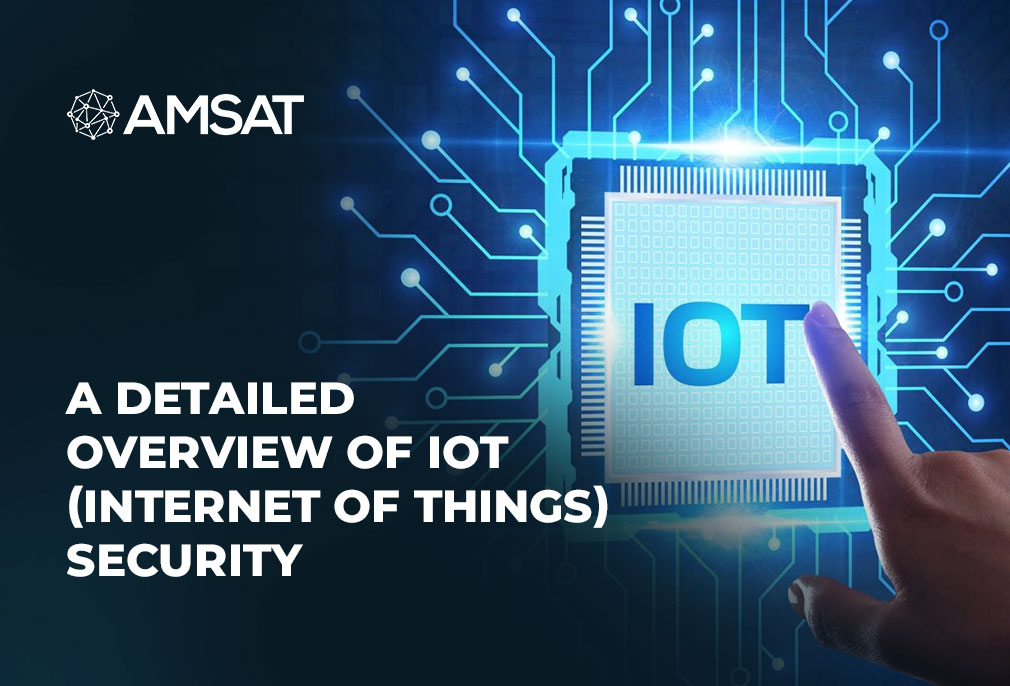Latest Blogs

By AMSAT July 12, 2021
A Detailed Overview of IoT (Internet of Things) Security
IoT, or the Internet of Things, incorporates everything linked to the internet, but it is widely used to define objects that speak to each other. In simple words, the IoT is made up of devices such as simple sensors to smartphones and wearables linked together. The arrival of highly affordable computer chips and the omnipresence of wireless networks have ensured that anything from as small as a needle to as large as an airplane can be easily converted into a part of the Internet of Things. Linking up all these diverse objects and adding sensors to them allow them to transfer real-time data without a human’s involvement. The IoT is making the world around us much smarter and more receptive, integrating the digital and physical worlds.
How IoT works
The internet has changed the way we work and interact with one another. Similarly, IoT has also transformed our lives by linking numerous devices simultaneously to the internet, thus enabling human-to-machine and machine-to-machine communications. Nevertheless, this IoT system is not limited to a specific field but has commercial applications in fields such as home, vehicle, and factory line automation, retail, healthcare and more. The connectivity, interacting and communication procedures used with these web-enabled devices mainly rely on the precise IoT applications arranged. IoT can also take advantage of artificial intelligence (AI) and machine learning to help make data accruing procedures easier and livelier.
Significance of IoT Device Security
The idea of IoT dates back to the 20th century as something of an accidental concept, but is now considered to be the future of our very livelihood, mainly due to astonishing technological developments and fast-paced consumer adaptability.
The potential for IoT execution is enormous. IoT is expected to lead to increased productivity and efficiency, reduced crime rates as well as accidents caused by human error. Yet, the success of IoT application at universal levels is under continuous risk from breach of secrecy and data security. Here are the key reasons why IoT device security is important.
Data is more valuable than anything else
The phrase “knowledge is power” has been taken to a whole new level by IoT technology that has been adapted in varied areas. Governments have executed the use of IoT devices in their activity processes such as the use of military drones while IoT devices are used by healthcare facilities and hospitals to provide high-quality healthcare services. The massive amount of data shared across different IoT devices makes these devices highly vulnerable to cybercriminals, swindlers and other immoral users interested in such data. The data, once landed in the wrong hands, could put the safety and security of entire companies and government agencies at stake.
Hackers emboldened by IoT device defects
While smartphone and computers have been around for a long time, IoT is a relatively new phenomenon. Therefore, manufacturers and software developers have had adequate time to address the vulnerabilities relating to their data breach. IoT devices, alternatively, are enormously useful and come with various capabilities. Manufacturers still face issues such as lack of hardware that is strong enough to scrutinize and encode data yet trivial enough to fit inside the restricted space. Threat actors can access your home Wi-Fi network through such indiscreet devices and use the opportunity to watch your home surveillance camera to perpetrate a crime.
Cybercriminals compromise the object of IoT execution
The key object of implementing IoT devices across several segments is to create a completely cohesive smart city. With this integration, any device used in a manufacturing industry can link to another being used by government organizations, healthcare providers, trades or even one’s home network. Nevertheless, the law is yet to formulate privacy protection laws that cover all weaknesses across the different sectors. Cybercriminals continue to take advantage of this shortcoming, which results in the loss of revenue already invested into the project.
Undoubtedly, IoT is the future of the world. However, manufacturers and software designers need to protect its data for comprehension of a smarter, safer and more resourceful world.
How to secure IoT networks
Here are some of the steps that can boost the security of your IoT network.
Know your IoT network
The first measure to take to enhanced security is to recognize and learn what you have and what needs to be safeguarded. While it may seem one of the fundamental steps, several companies tend to overlook this. Having an appropriate list of what’s on your IoT network and updating it regularly is key to security in any IoT network.
An IoT network usually comprises numerous devices and any of these devices can be used as a source to upset an entire IoT network. Organizations should focus on fixing the fundamentals to face the mounting cyber-risks in IoT.
IoT network security architecture
Most of the typically used surveillance devices hardly support the wireless network security standards such as WPA2 or WPA3, which makes them highly susceptible, capable of easily falling into the hands of cybercriminals. Companies find upgradation of all these devices very expensive, so they should think about redesigning their network security architecture.
Divide the responsibility
One of the key problems with IoT security is that companies often end up with security defects since they have too much to gain. Businesses that have their own IoT network typically acquire or hire equipment and services from a number of services or device providers. Since IoT has to do with all these devices working together in a network, this mix of equipment can open up several holes that can be used to upset the system.
Setting up one-way connections
Setting up one-way connections is very important in an IoT network. If the endpoints in an IoT network have more privileges, threat actors can exploit them for cyberattacks. With the increase in the number of devices being a part of the IoT, the surface area for the invaders to attack is also on the rise. Hence, organizations should restrict the skills of these IoT devices for security purposes. Often, IoT devices are arranged in a way that they can start network connections by themselves. Although this provides much flexibility and other gains, it can also lead to many security problems. By applying the exercise that all IoT devices are able to stay connected or start connections only using network firewalls and access lists will ensure better safety.
TAGS
- Cyber Crime
- IoT
- Internet of Things
Recent Blogs
Ready to Get Started?
Our specialists are ready to tailor our security service solutions to fit the needs of your organization.









